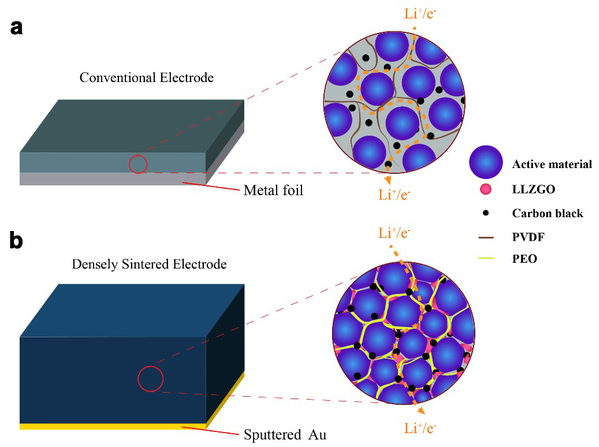Recently, SPST Dr. Liu Wei’s group reported new progress in fabricating high-performance electrode for lithium-ion batteries in a paper entitled “High-Performance, Low-Cost, and Dense-Structure Electrodes with High Mass Loading for Lithium-Ion Batteries” in the journal Advanced Functional Materials.
The lithium-ion battery has now been widely used in portable electronics. However, their energy density is not enough to satisfy the need for electrical cars and other large-scale energy storage. One way to improve the energy density of lithium-ion batteries is to increase their electrode thickness and the mass loading of the active materials. Other published research has mainly focused on using porous structure to improve the areal capacity of the lithium-ion battery which is complicated and high cost. Dr. Liu Wei’s group proposed a new electrode structure with high density. CSP is a new technique which could enable the co-sintering of organic polymer and inorganic oxides in a low-cost and eco-friendly environment. By applying it into the fabrication of the electrode and adding Ga-doped Li7La3Zr2O12 (LLZGO) which is a nano-sized ionic conductor, enhanced the electrochemical reaction kinetics inside the electrode. The areal capacity of it is also 16 times higher than the commercial one. By optimizing the fabrication parameters, the densified thick electrode can have a good cyclability along with ultra-high areal capacity.
On considering the theoretical guiding significance and promising in practical application, a reviewer in Advanced Functional Materials praised the work as being “of high interest to the broad readers in the material and energy fields.”
All of the research work in this paper were completed at ShanghaiTech University. The first author of this paper Wu Xinsheng, is a fourth-year undergraduate. Dr. Liu Wei is the corresponding author. ShanghaiTech University is the first responsible institution. The Transmission Electron Microscope characterization in this work was supported by the graduate students Hu Xiangchen and Yuan Biao in Dr. Yu Yi’s group. Other characterizations are supported by post-doctoral student Xia Shuixin and undergraduate students Huang Yuanqi and Chen Shaojie. This work is also supported by ShanghaiTech University start-up funding, National Natural Science Foundations of China and other funding.

Schematic illustration of the traditional electrode structure and the novel densely sintered electrode

